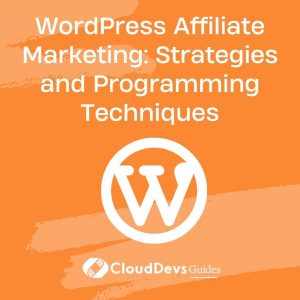Building an Online Learning Platform with WordPress Programming
In today’s digital age, online learning has gained immense popularity, providing individuals with the flexibility to acquire new skills and knowledge from the comfort of their own homes. If you’re considering venturing into the realm of e-learning, creating a robust online learning platform is essential. WordPress, with its user-friendly interface and versatile architecture, offers a fantastic foundation for building such a platform. In this guide, we’ll walk you through the process of creating your own online learning platform using WordPress programming, complete with code samples, helpful tips, and best practices.
Table of Contents
1. Setting Up Your WordPress Environment:
Before diving into the development process, it’s crucial to set up a proper environment for your online learning platform.
1.1. Domain and Hosting:
Choose a relevant domain name and select a reliable hosting provider to ensure your platform performs well and is easily accessible to users.
1.2. Installing WordPress:
After acquiring hosting, install WordPress using the provided tools or manual installation methods. Most hosting providers offer one-click installations for convenience.
2. Choosing the Right Plugins:
WordPress’s extensibility is one of its defining features. To build a robust online learning platform, you’ll need to choose the right plugins that enhance its functionality.
2.1. LearnDash – The Learning Management System (LMS):
LearnDash is a powerful LMS plugin that enables you to create and manage courses, lessons, quizzes, and assignments seamlessly.
php
// Install LearnDash plugin
function install_learndash() {
$plugin = 'sfwd-lms/learndash.php';
include_once( ABSPATH . 'wp-admin/includes/plugin.php' );
if (!is_plugin_active($plugin)) {
activate_plugin($plugin);
}
}
add_action('init', 'install_learndash');
2.2. WooCommerce:
To handle payments for your courses, WooCommerce integrates seamlessly with LearnDash, allowing you to sell your courses as products.
php
// Install WooCommerce plugin
function install_woocommerce() {
$plugin = 'woocommerce/woocommerce.php';
include_once( ABSPATH . 'wp-admin/includes/plugin.php' );
if (!is_plugin_active($plugin)) {
activate_plugin($plugin);
}
}
add_action('init', 'install_woocommerce');
3. Designing Your Online Learning Platform:
The appearance of your platform plays a significant role in user engagement. A clean and user-friendly design is crucial.
3.1. Choosing a Theme:
Select a responsive and customizable theme that aligns with the nature of your courses. Opt for a design that enhances readability and navigation.
3.2. Customizing the Design:
Use the WordPress Customizer to tailor the theme’s appearance according to your brand identity. Pay attention to color schemes, typography, and layout.
4. Creating and Managing Courses:
Now that your foundation is set, it’s time to start creating courses and managing their content.
4.1. Course Creation:
Within LearnDash, create your courses by defining their titles, descriptions, and categories. Each course will act as a container for your lessons.
4.2. Lesson Creation:
Break down your courses into individual lessons. Each lesson should have a clear title, description, and associated content.
4.3. Adding Quizzes and Assignments:
Enhance the learning experience by incorporating quizzes and assignments. These can be added to each lesson to reinforce understanding.
5. User Interaction and Engagement:
To keep your learners engaged, provide opportunities for interaction and communication.
5.1. Discussion Forums:
Integrate a discussion forum plugin to enable learners to ask questions, share insights, and collaborate with their peers.
php
// Install bbPress plugin for discussion forums
function install_bbpress() {
$plugin = 'bbpress/bbpress.php';
include_once( ABSPATH . 'wp-admin/includes/plugin.php' );
if (!is_plugin_active($plugin)) {
activate_plugin($plugin);
}
}
add_action('init', 'install_bbpress');
5.2. Gamification Elements:
Incorporate gamification elements like badges, certificates, and progress tracking to motivate learners to complete their courses.
6. Securing Your Platform:
Security is paramount for an online learning platform, as it involves sensitive user data.
6.1. SSL Certificate:
Install an SSL certificate to encrypt data transmitted between users and your platform, ensuring their privacy.
6.2. Regular Backups:
Implement automated backup solutions to safeguard your platform’s data and content in case of any unforeseen events.
7. Performance Optimization:
A fast and responsive platform is essential for user satisfaction.
7.1. Image Optimization:
Compress and optimize images to reduce loading times without compromising quality.
7.2. Caching and Content Delivery Networks (CDNs):
Utilize caching plugins and CDNs to serve content more efficiently to users across the globe.
8. Launching Your Platform:
With your online learning platform ready, it’s time to launch it to the world.
8.1. Testing:
Thoroughly test your platform’s functionality, usability, and responsiveness across different devices and browsers.
8.2. Marketing and Promotion:
Create a marketing strategy to promote your courses. Utilize social media, email marketing, and SEO techniques to attract learners.
Conclusion
Building an online learning platform using WordPress programming offers immense potential for educators and entrepreneurs to share their expertise while providing a flexible learning experience. By following the steps outlined in this guide and leveraging the power of WordPress plugins and customization options, you can create a dynamic and engaging platform that caters to the needs of your learners. Remember, the journey doesn’t end at launch; continuous improvement and updates will contribute to the success and growth of your online learning venture. So, dive in, explore, and create an impactful online learning platform that leaves a positive mark on your learners’ lives.
Table of Contents








